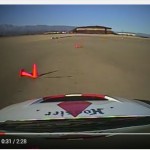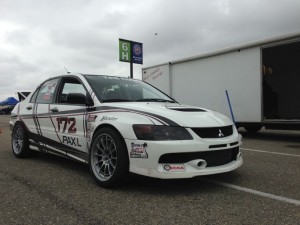Turn on suggestions
Auto-suggest helps you quickly narrow down your search results by suggesting possible matches as you type.
Cancel
- Home
- :
- All Communities
- :
- Industries
- :
- Education
- :
- Education Blog
- :
- Start your engines! Analyzing car race data in Arc...
Start your engines! Analyzing car race data in ArcGIS Online
Subscribe
6331
0
08-18-2016 11:00 PM
- Subscribe to RSS Feed
- Mark as New
- Mark as Read
- Bookmark
- Subscribe
- Printer Friendly Page
08-18-2016
11:00 PM
One of my colleagues at Esri has a hobby that is quite exciting - she races cars. Timing is everything. During her first race at "nationals", she won by 9 thousands (.009) of a second! But besides timing, a wide variety of other data are collected during each race. These data can be mapped in ArcGIS Online and used in education to foster spatial thinking in geography, physics, mathematics, and other disciplines. For her recent race at Auto Club Speedway in Fontana, California, where she was driving a Mitsubishi Evolution Lancer, I created a web map based on the data she generously provided. Use the map with the following guiding questions, or make up your questions. Investigate the data while fostering spatial thinking using this engaging topic! Be sure to show your students this video of the first time my colleague drove this type of car and a more recent video here (but be sure to hold on while watching!).Each racing event uses a custom course, which is marked off with pylon cones. What do you notice about the spatial pattern of this course? How many sharp curves did it include? Go to the bookmark "Best Scale". Use the measure tool and measure the distance that the car drove between the start and finish line using the "Track of Race Car" layer as your guide when measuring. Compare that distance against the straight line distance between the two locations.
Turn on the other map layers and open their tables to investigate the following questions:
Examine the Speed MPH layer. What was the speed achieved around the first curve? Where did the vehicle achieve its maximum speed? What is the relationship of speed to the curvature of the track? What was the speed across the finish line?
Turn on the acceleration layer. What is the lateral acceleration around the first curve? What was the range of acceleration around the race course? What is the relationship of acceleration to speed? Examine the oil pressure PSI layer. What is the relationship of the oil pressure to speed? Why?
Each of the data points was resampled for a reading every 0.12 seconds. For additional math and physics integration, measure the distance between two adjacent data points in feet or meters, determine how long it took my colleague to cover that distance, and calculate speed in kph or mph based on your measurements.
Change the style of one of your map layers to 'gear.' What gear was the driver in most of the time? Why do you suppose this was the case?
Examine the steering wheel angle layer. The Steering_P is given in angles from 0 (due north) with positive numbers to the right (+90=sharp right turn) and negative numbers to the left (-270=sharp left turn). What is the relationship of the steering wheel direction to the curves? From the steering wheel position, can you determine where the quick left-and-right motions occurred, indicating where a slalom was set up and requiring the driver to go back and forth around cones? Run statistics on the attribute Steering_P and you will see the range, and that the average (just over the value of 1) is just about "straight ahead". In other words, all of the curves average out! Try using one of the rotational symbols in ArcGIS Online to visualize the direction of the steering wheel more effectively.
What other variables and tools could you use to analyze the data using ArcGIS Online? Try investigating the g-force (vector), braking velocity, and lateral force. Try some of the analysis tools in ArcGIS Online to determine hot spots of understeer angle or other variables. Have fun and think spatially!

You must be a registered user to add a comment. If you've already registered, sign in. Otherwise, register and sign in.
About the Author
I believe that spatial thinking can transform education and society through the application of Geographic Information Systems for instruction, research, administration, and policy.
I hold 3 degrees in Geography, have served at NOAA, the US Census Bureau, and USGS as a cartographer and geographer, and teach a variety of F2F (Face to Face) (including T3G) and online courses. I have authored a variety of books and textbooks about the environment, STEM, GIS, and education. These include "Interpreting Our World", "Essentials of the Environment", "Tribal GIS", "The GIS Guide to Public Domain Data", "International Perspectives on Teaching and Learning with GIS In Secondary Education", "Spatial Mathematics" and others. I write for 2 blogs, 2 monthly podcasts, and a variety of journals, and have created over 6,500 videos on my Our Earth YouTube channel.
Yet, as time passes, the more I realize my own limitations and that this is a lifelong learning endeavor: Thus I actively seek mentors and collaborators.
Labels
-
Administration
77 -
Announcements
80 -
Career & Tech Ed
1 -
Curriculum-Learning Resources
257 -
Education Facilities
24 -
Events
72 -
GeoInquiries
1 -
Higher Education
594 -
Informal Education
281 -
Licensing Best Practices
90 -
National Geographic MapMaker
33 -
Pedagogy and Education Theory
224 -
Schools (K - 12)
282 -
Schools (K-12)
272 -
Spatial data
35 -
STEM
3 -
Students - Higher Education
245 -
Students - K-12 Schools
128 -
Success Stories
36 -
TeacherDesk
1 -
Tech Tips
117
- « Previous
- Next »

